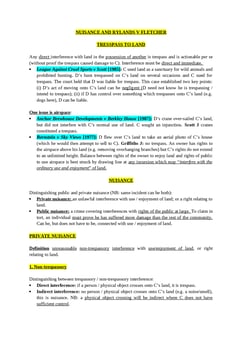Anns v Merton LBC [1978] AC 728; [1977] 2 WLR 1024; [1977] 2 All ER 492
Judgement for the case Anns v Merton LBC
KEY POINTS
-
Negligence revolves around the duty of care of local authorities, particularly in inspecting building foundations.
Allegations may arise regarding a lack of inspection or negligence before granting construction approval. This becomes necessary when a block of maisonettes has latent defects, causing subsequent occupiers damage.
The question then arises about the local authority's liability under the Public Health Act of 1936.
-
In cases of defective premises, the Limitation of Action becomes significant.
For instance, if there are claims of negligence in approving foundations, initiating legal action more than six years after approval raises the question of whether the claim is statute-barred.
The issues between duty of care, inspection powers, and legal limitations show the challenges in local authorities and building construction cases.
FACTS
Michael Ralph Anns (“Respondents”) were lessees of seven flats in a 1962 Wimbledon block. The builders, who were the owners, granted long leases to only two original lessees.
In 1970, structural issues emerged, leading to writs in 1972 against the builders and local authority appellants.
The claims alleged negligence, citing the London Borough of Merton's (“Appellants”) approval of shallow foundations and inadequate inspections, which violated building bylaws.
The Appellants argued a statute-barred defense based on property conveyance dates.
In 1975, Judge Edgar Fay ruled the claims were time-barred from 1965.
-
The Court of Appeal, following Sparham-Souter v. Town and Country Developments (Essex) Ltd. [1976] Q.B. 858, allowed the appeal.
The House of Lords granted Appellants leave to argue whether they owed any duty of care to the Respondents.
JUDGEMENT
-
The court held that a local authority, as a public body, operates under public, not private law.
The Appellants had a duty to consider inspections and were not immune from attack.
The standard of care for inspections was linked to bylaw compliance. A duty of care at common law might exist outside legitimate discretion.
The question of duty was considered in relation to powers and duties under the Public Health Act 1936.
-
The Appellants would breach duty if their inspector failed to exercise reasonable care during inspections.
Passing a resolution to avoid all inspections might be an improper exercise of discretion but may not confer the right to sue for damages.
None of the actions were barred by the Limitation Act 1939, leading to the dismissal of the appeal.
The Court of Appeal's decision was affirmed.
COMMENTARY
-
The case involves allegations of negligence by the London Borough of Merton in approving faulty building foundations, leading to structural issues in a 1962 Wimbledon block.
The Respondents, lessees of seven flats, initiated legal action in 1972, countered by the Appellants' statute-barred defense.
-
The court held that local authorities operate under public law, emphasizing their duty to consider inspections linked to bylaw compliance.
The Appellants could be liable for breach of duty if their inspector failed to exercise reasonable care during inspections.
Avoiding inspections might be an improper exercise of discretion but may not confer the right to sue for damages.
None of the actions were barred by the Limitation Act 1939, leading to the dismissal of the appeal.
The case shows the complexities in balancing the duty of care, inspection powers, and legal limitations in cases involving local authorities and building construction.
ORIGINAL ANALYSIS
Plaintiffs were letters of flats over which R had rights and duties of owner.
Cracks appeared in the walls and Plaintiffs sued R for negligence, after R failed to carry out any inspection of the building.
HL held that Plaintiff could sue R for negligence: R was under a duty to consider whether an inspection was needed; that this duty required “reasonable care” to be taken.
-
Test for duty of care:
Is there proximity (reasonable foreseeability/neighbourhood)? if so,
Is there any reason not to apply the duty here?
Lord Wilberforce
In order to see if a duty of care arises:
First one has to ask whether, as between the alleged wrongdoer and the person who has suffered damage there is a sufficient relationship of proximity or neighbourhood such that, in the reasonable contemplation of the former, carelessness on his part may be likely to cause damage to the latter - in which case a prima facie duty of care arises.
Secondly, if the first question is answered affirmatively, it is necessary to consider whether there are any considerations which ought to negative, or to reduce or limit the scope of the duty or the class of person to whom it is owed or the damages to which a breach of it may give rise.
(this is expansive in that it assumes a claim is valid if there is proximity, and there has to be a reason for disallowing it, whereas Caparo’s third stage test asks is there any reason to allow duty of care to be imposed, i.e. more restrictive assumption that claim is not good just because proximity/foreseeability is proved).
It is not necessary to see if the exact circumstances have been covered before, so long as the above principal applies.
RELATED CASES
For Further Study on Anns v Merton LBC
Need instant answers? Our AI exam tutor is here to help.
Ask questions 🙋 Get answers 📔 It's simple 👁️👄👁️
Our AI is educated by the highest scoring students across all subjects and schools. Join hundreds of your peers today.
Get StartedSimilar Cases
Related Product Samples
These product samples contain the same concepts we cover in this case.
| Tort Law | Duty Of Care Notes (7 pages) |
| Tort Law | Negligence Duty Of Care Notes (35 pages) |

 Since 2010, Oxbridge Notes has been a trusted education marketplace, supplying high-quality materials from top achievers at universities like Oxford, Cambridge, LSE, Harvard, and Yale.
Since 2010, Oxbridge Notes has been a trusted education marketplace, supplying high-quality materials from top achievers at universities like Oxford, Cambridge, LSE, Harvard, and Yale.